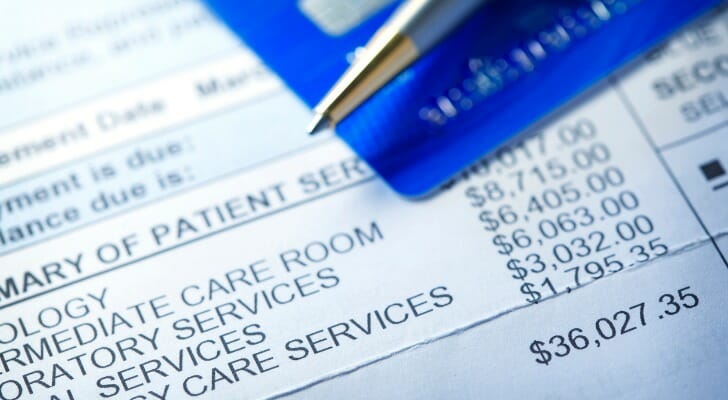
Paying for health insurance and medical bills can get expensive. Luckily, you can recoup some of those costs when you file your taxes by taking a deduction for medical expenses. To do so, the expenses in question must meet the qualifications outlined by the IRS. We’ll show you how to figure out whether your expenses qualify, and how to calculate and take your deductions. And once you’ve figured out your deductions, a financial advisor could help you connect your tax strategies with your overall financial goals.
What Are Medical Expenses?
The IRS defines medical expenses as the “costs of diagnosis, cure, mitigations, treatment, or prevention” of an injury or disease. These expenses include payments to doctors and other medical practitioners, prescriptions and insulin, X-rays and laboratory tests, eyeglasses and contact lenses, and nursing help and hospital care, among others. If you have medical care provided to you then its best to keep track of expenses in case it qualifies.
Calculating Your Medical Expense Deduction

President Trump’s Tax Cuts and Jobs Act allowed taxpayers in 2017 and 2018 to deduct the total amount of medical expenses that exceed 7.5% of their adjusted gross income (AGI). This threshold was originally scheduled to go up to 10% of AGI in 2019, but the 7.5% of AGI was extended to tax year 2021. The Consolidated Appropriations Act of 2021 made the 7.5% threshold permanent.
You can get your deduction by taking your AGI and multiplying it by 7.5%. If your AGI is $50,000, only qualifying medical expenses over $3,750 can be deducted ($50,000 x 7.5% = $3,750). If your total medical expenses are $6,000, you can deduct $2,250 of it from your taxes.
Note, however, that you’ll need to itemize deductions to deduct medical expenses. Itemizing deductions only makes sense if the total deductions you qualify for would exceed your standard deduction – a fixed dollar amount that reduces the amount of money you’re taxed on.
The Tax Cuts and Jobs Act effectively doubled the standard deduction, which makes it less likely that you’ll wind up itemizing. For the tax year 2023, which you’ll file in 2024, the standard deduction limits are as follows:
- Single or married filing separately — $13,850 ($15,350 if they’re at least 65)
- Married filing jointly or qualifying widow(er) — $27,700
- Head of household — $20,800
These increase for the 2024 tax year to:
- Single or married filing separately — $14,600 ($16,100 if they’re at least 65)
- Married filing jointly or qualifying widow(er) — $29,200
- Head of household — $21,900
If the value of your total itemized deductions exceeds your standard deduction, you’ll need to complete a Form 1040 and detail every deduction in an itemized list. The standard deduction may be easier, but if you paid a lot of healthcare expenses or have other deductible expenses, they could help you reduce your tax bill.
Medical Expenses You Can Deduct

Many medical-related costs can be included in your itemized deductions. Remember that you can only claim medical expenses that you paid for this year, whether it’s for you, your spouse or another dependent. Dependents can include children and other relatives you care for. Here are the expenses that qualify:
- Payments you’ve made to doctors, surgeons, dentists, chiropractors, psychiatrists, psychologists and some other nontraditional medical practitioners
- Insurance premiums for health or long-term care coverage for itemizers on Schedule A
- In-home nursing care and inpatient hospital care
- Inpatient treatment for alcohol or drug addiction
- Acupuncture treatments
- Reproductive health: Abortions, birth control and fertility treatments
- Sterilization, including vasectomies
- Breast pump and other breastfeeding-related supplies, not including bottles
- Organ donation and transplants
- Smoking cessation programs and prescription drugs that help with nicotine withdrawal
- Weight-loss programs for a disease diagnosed by a physician
- Insulin and related prescription drugs
- Admission and transportation to a medical conference that relates to a chronic illness you, your spouse or a dependent is suffering from
- False teeth, prescription glasses, contacts, hearing aids, crutches, wheelchairs, guide dogs and service animals
- Costs for transportation to and from medical care facilities, including taxis, buses, trains and ambulances. If using your car, standard mileage rate reimbursements qualify (20 cents per mile), as well as out-of-pocket expenses for gas and oil.
A self-employed health insurance deduction is allowed for those who qualify, but it’s adjusted for income and not an itemized deduction.
Medical Expenses You Can’t Deduct
While there’s a decent amount of healthcare costs you can itemize on your taxes, there are a few that don’t qualify, including:
- Funeral or burial expenses
- Nonprescription medicines
- Toothpaste, toiletries and cosmetics
- Trip or program for the general improvement of health
- Most cosmetic surgery
- Nicotine gum and patches that don’t require a prescription
- Meals and lodging while attending a medical conference
- Future medical expenses
- Babysitting or childcare
- Gym or health club memberships
- Maternity clothes
- Household help, even if it was recommended by a doctor for your care
- Nutritional supplements
Any medical expenses that you already get reimbursed for, whether from insurance or from your employer, can’t be deducted from your taxes. You also can’t deduct your employer’s share of health insurance premiums. If you’re still not sure which expenses qualify, you can determine if it’s eligible through the IRS.
Bottom Line
There are plenty of qualifying medical expenses that you can claim on your taxes. However, you can only deduct expenses that exceed 7.5% of your adjusted gross income. And if your total itemized deductions don’t exceed the new, higher standard deduction, then you won’t take the deduction. Review the list of expenses that qualify (and the ones that don’t), and decide whether it makes sense to take this deduction.
Tax Planning Tips
- You might want to take an extra step and work with a financial advisor who can address your overall financial situation — from taxes to investments and retirement. Finding a financial advisor doesn’t have to be hard. SmartAsset’s free tool matches you with up to three vetted financial advisors who serve your area, and you can have a free introductory call with your advisor matches to decide which one you feel is right for you. If you’re ready to find an advisor who can help you achieve your financial goals, get started now.
- A financial advisor can help lower your taxes by harvesting your losses. This means that you use your investment losses to lower your taxes on capital gains. And if you’re self-employed, an advisor can help you avoid employment taxes by structuring your business to pay you in dividends.
- Once you’ve figured out your deductions, you might want to see what your tax return could look like. Use SmartAsset’s tax return calculator to estimate the size of your refund or bill. If your taxes are complicated, it’s a good idea to work with a professional tax preparer or a tax prep program.
Photo credit: ©iStock.com/cbies ©iStock.com/NoDerog, ©iStock.com/scyther5, ©iStock.com/DNY59